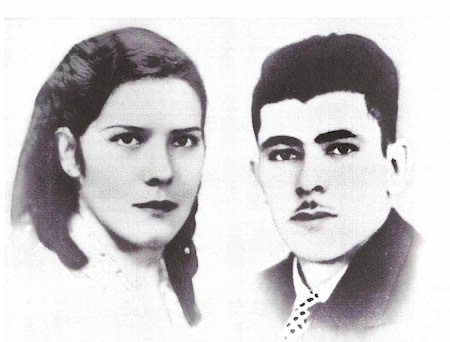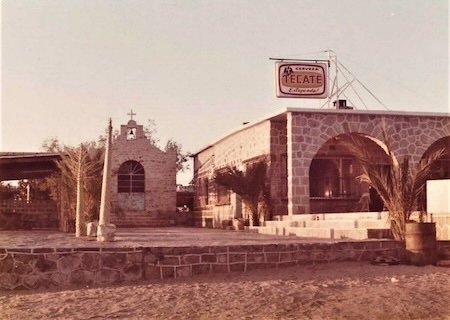 |  |
By Greg Niemann

Rather than enjoying an idyllic island-studded bay, early visitors to Bahía de los Ángeles were attracted to deposits of gold, silver, and copper in the hills to the south. From 1880 to 1910 hardy foreigners worked mines in that area they called Las Flores and they even established a mill there. After mining operations ceased in 1910 the area languished.
Decades later, an energetic young man named Señor Antero “Papa” Diaz realized that the treasures of the area would be from the sea rather than the mines. He wanted to attract American sportsmen to the outstanding midriff fishery on the picturesque bay.
Unfortunately, the area was an arduous three-day overland journey from Ensenada. Undaunted, by the 1940s Papa Diaz had scraped a small airplane landing field, built six small cabins with primitive showers and opened a dining room that would be presided over by his wife Cruz Rosas Ortiz “Mama” Diaz. Calling the enterprise Casa Diaz, the pair soon became enduring Baja legends.
Both born in the Mexico City area, they got married in 1939 when 25-year-old Antero came to Baja California to work in the mines. He worked at Calmalli to the south and Desengaño just to the north of Bahía de los Ángeles. Even though the pair moved back and forth from Baja to Mexico City several times, it was in Bahía de los Ángeles where they established their roots and became well known.
There were just a handful of families in the area at the time. In addition to Diaz there were mostly the Daggetts (the children and grandchildren of the Englishman Dick Daggett Sr. who had jumped ship and worked the mines) and the large family of another mine worker Tilongo Smith (I’ve gone fishing with several descendents of that family, including Tilongo’s son Pepe Smith. For example, Tilongo’s grandson Fermin Smith was then the village “delegado” or mayor). In addition, there were the Ocanas, Navarros, Verdugos and Corderos. Even today, almost the entire native populace of about 800 is from one of those families.
In 1941 there was just a small group of villagers at “Ángeles Bay” to greet writer John Steinbeck and marine scientist Edward Ricketts when their Western Flyer made anchor there: “The Coast Pilot had not mentioned any settlement, but here there were new buildings, screened and modern, and on a tiny airfield a plane sat. It was an odd feeling, for we had been a long time without seeing anything modern. Our feeling was more of resentment than of pleasure. We went ashore about three thirty in the afternoon, and were immediately surrounded by Mexicans who seemed curious and excited about our being there. They were joined by three Americans who said they had flown in for the fishing, and they too seemed very much interested in what we wanted until they were convinced it was marine animals….”
By the 1950s it was still a small settlement of 60 people and Antero became “delegado” of Bahía de los Ángeles.
Fly-in sport fishing

Antero “Papa” Diaz gradually began to develop his fly-in sport fishing business and by the 1950s he operated the general store, a small service station for autos and planes, two landing fields, one along the beach (north-south) and the other about a mile away on a mesa (east-west).
With profits he built the distinctive stone buildings of Casa Diaz, opening the original buildings in 1960. Today’s main complex, which includes the arched store, restaurant and some of the guest rooms was completed in 1963. Papa and Mama Diaz offered a family-style restaurant, boats for rent, clean quarters with showers, ice, and a smokehouse for fish. Antero also ran a large turtle business back then before they became endangered, sending 60-80 turtles each trip to Tijuana and points north.
To develop his community, Antero Diaz built the one-room original schoolhouse, even encouraging American sportsmen to help kick in. He also built the little chapel outside of Casa Diaz, using blocks of onyx from the El Marmol quarry. Señor Diaz regularly used to read stories from a Spanish newspaper to groups of illiterate men who would gather outside his store.
Home-cooked meals at Casa Diaz
Rooms at Casa Diaz included meals and Mama Diaz became a legend preparing sumptuous banquets from the sea. In 1961 Marion Smothers said in “Vintage Baja,” “You’ve never really had yellowtail until you’ve sampled Mama’s, only hours from your jig to her pan to your plate. And if Antero ruled the campo, Mama ruled Antero—make no mistake about that!”
In 1961 author Erle Stanley Gardner wrote of Bahía de los Ángeles, “It is known to scores of sportsmen having private planes, and on weekends plane after plane will come in bringing adventurous fishermen or people who simply want to make the trip and relax in the warm sunshine of the gulf, or perhaps to get in a little fishing; but above all, to sample the fabulous cooking prepared under the direction of Señora Diaz.”
Six years later, he continued the compliment in a different book by writing, “Bahía de los Ángeles has some of the best home-cooked food anyone could ask for. Señora Diaz cooks lobster and fish so sweet and tender they will melt in your mouth.”

An interesting sidelight that few people are aware of is that one of America’s greatest heroes and by far its most famous aviator, Charles Lindberg, flew a small plane into Bahía de los Ángeles. He spent the day and only one known photograph recorded his visit. It’s at the village museum showing Lindberg posed with Mama Diaz.
The road to Bahía de los Ángeles was paved in October 1974, a 40-mile one-way access off of Highway 1. That same year Cliff Cross in his book “Baja California” wrote, “Casa Diaz has a unique feature. When the evenings are warm, the indoor innersprings beds are given up for Mexican cots on the cooler porch where guests can look up at the stars.”
My first visit to Bahía de los Ángeles was also in the 1970s. A friend and I enjoyed Mama’s family-style dinner and we too slept out among the stars. Over the next three decades I’d been to the area several times and often noted many guests dragging their bunks out to the porch to catch the breeze off the gulf.
Antero Diaz, the village founder who was born in 1914, died in 1989. A eulogy written by Baja author Tom Miller explains the attitude of many: “The relationship of Papa Diaz with the Baja old-timers – the pilots, off-roaders, fishermen and other adventure types who entered his always open door – was special. I am richer for having known Antero “Papa” Diaz, as are thousands of others.”
His widow, Cruz Rosas Ortiz “Mama” Diaz, who was being cared for by family members her last few years, died in Ensenada in October 2000. Casa Diaz is still being run by the Diaz family.
The seven children of Antero and Cruz: Rosa Maria, Rafaela, Aurora, Anita, Elvira, Sammy and Antero Jr. were all born between 1937 and 1952. Sammy, the oldest boy and his two sons have run the fishing operation and the fuel supply and tire shop. Sammy also has two daughters, Anita and Rosa. Antero Jr., who had three daughters, runs the store, restaurant and guest rooms. Antero Jr. is known as “Chubasco” to the townsfolk because it is said he was born during a violent storm or “chubasco.” The family members continue on the tradition of Mama and Papa.
The town has grown up around the original Casa Diaz. Now there are several markets, restaurants, other motels, campgrounds, fishing operations, and more.

The air strip that was in the heart of town, has, in the interest of safety, been scuttled and a larger, paved airport was constructed north of town. I am in awe of the fine quality of the Natural History and Cultural Museum of Bahía de los Ángeles. There are fossil and shell exhibits, extensive exhibits from the indigenous Cochimi and other Indians, missionary information, and mining and ranching exhibits. There are T-shirts, postcards and historical photos, and outdoors are whale skeletons and a native botanical garden. It is well worth a visit.
Bahía de los Ángeles is, for the most part, still a quiet little town, but those who’ve been drawn to the area for years have seen it grow. Approximately 400 Americans have homes or winter in the area. The Casa Diaz is no longer the center of town. But everyone knows that that’s where the Bahía de los Ángeles began.
About Greg
Greg Niemann, a long-time Baja writer, is the author of Baja Fever, Baja Legends, Palm Springs Legends, Las Vegas Legends, and Big Brown: The Untold Story of UPS. Visit www.gregniemann.com.